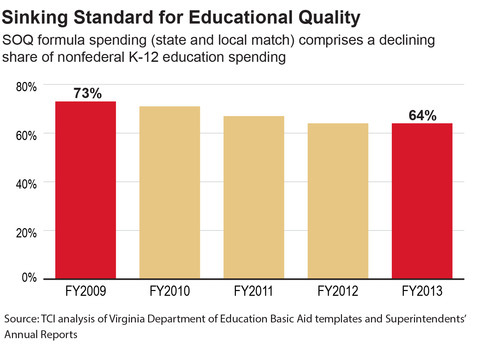May 22, 2014
Lowering the Bar
When it comes to learning the basics, students seldom get away with cutting corners. We should hold state policymakers to the same standard, especially when they’re doing the math to determine the cost of providing K-12 students with a quality education.
Unfortunately, lawmakers have cut corners in recent years by changing Virginia’s basic standards for school funding, called the Standards of Quality (SOQ). Tweaks to the SOQ formula have chipped away at the state’s definition of adequate funding, lowering the floor for state and local contributions to K-12 schools. Many changes to the formula were prompted by temporary state budget shortfalls, but once in place they have become difficult to shake.
As a result, last year’s required SOQ formula spending accounted for 64 percent of nonfederal spending on K-12 education in Virginia, a nine percentage point decrease from 2009.

As state SOQ funding declines, school divisions become more reliant on local funding. But not all localities have the ability to make up the difference. Since school divisions in low-income parts of the state have fewer resources to tap than wealthy areas, students are at greater risk of having the quality of their education depend largely on where they live.
It’s already clear that localities are picking up more of the tab for education: In FY2009, the year before lawmakers started cutting state spending because of the recession, overall local spending per pupil exceeded the state amount by about $420. The next year the difference leapt to about $1,020, and it has remained above $1,000 every year since.
As the Senate and House of Delegates wrangle over the state’s budget, they face a choice over whether to continue watering down the funding standards. Here’s a key example: Some of the budget proposals on the table fail to account for the rising costs of basic school expenses, like utilities and textbooks – so-called “non-personal inflation updates.” But ignoring these costs, or low-balling the estimates for them, doesn’t make them go away. It just puts the responsibility squarely on local school divisions.
Some policymakers have argued that the formula changes won’t affect learning. But heating, cooling, and electricity are things that schools can’t go without. And when the rising costs of those necessities – some $76.4 million statewide – aren’t reasonably accounted for in the funding formula, school divisions face pressure to make up the difference in ways that could directly affect teaching and learning.
The SOQ formula is the way the state defines and funds quality in K-12 education. When policymakers water down that formula, they shortchange students and weaken the state’s economic future. That’s not a good lesson plan.
–Hope Richardson, Policy Analyst
